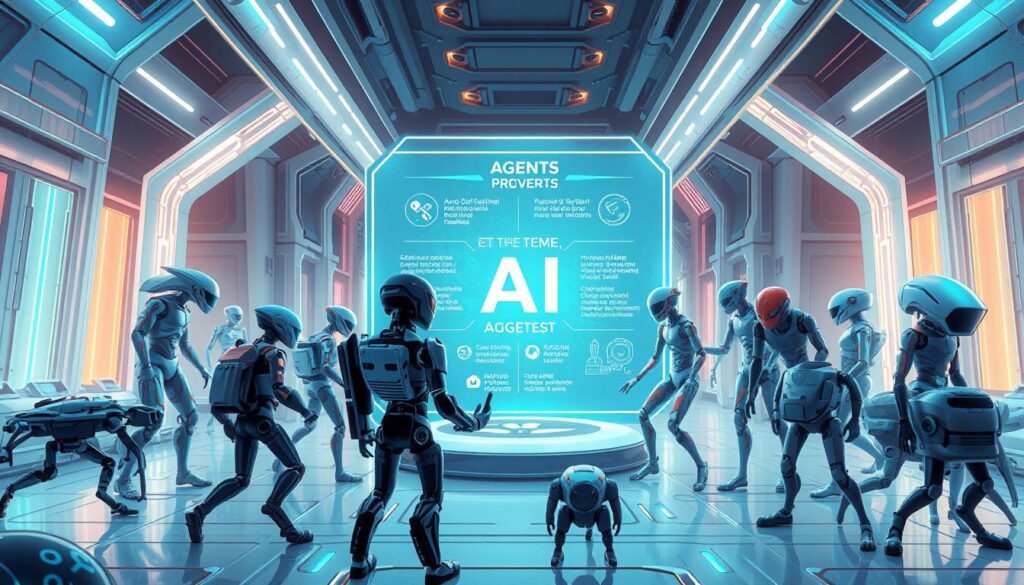Modern technology has reached a critical inflection point. Over 50% of users now interact with advanced software systems capable of independent decision-making, marking a decisive move beyond basic automation tools like ChatGPT. These next-generation solutions operate without rigid programming, adapting strategies in real time through environmental analysis and experiential learning.
Unlike conventional chatbots, these autonomous systems demonstrate three revolutionary traits. First, they function with minimal oversight, interpreting complex data patterns rather than following scripted responses. Second, they pursue objectives through dynamic problem-solving, adjusting tactics when faced with new variables. Third, their machine learning frameworks evolve continuously, improving performance through accumulated insights.
The rapid adoption of these technologies reflects their practical value across industries. Financial institutions deploy them for fraud detection, while healthcare organizations use predictive models for patient care optimization. This versatility stems from their ability to process unstructured inputs – from text conversations to sensor data – and generate context-aware outputs.
Key Takeaways
- Autonomous systems now influence half of all tech interactions globally
- Decision-making capabilities surpass traditional rule-based programs
- Continuous learning mechanisms enable performance improvements
- Applications span finance, healthcare, and operational management
- Environmental awareness drives context-specific solutions
Understanding AI Agents

Dynamic problem-solving defines the new era of intelligent software applications. These systems analyze real-world conditions through multiple input channels, assess potential outcomes, and execute context-specific actions without constant human oversight. Unlike conventional automation tools limited to preset rules, they demonstrate adaptive reasoning that evolves through iterative learning.
What Constitutes an Autonomous Software Entity?
An autonomous software entity operates through three interconnected capabilities: environmental perception, logical analysis, and strategic execution. It processes diverse data types – from text inputs to sensor readings – using advanced language models as its cognitive foundation. This architecture enables context-aware adjustments during operations, a critical differentiator from rigid workflow automations.
Operational Mechanics of Adaptive Systems
These systems follow a four-phase cycle when handling tasks:
- Data interpretation through natural language processing
- Scenario evaluation using multi-layered prompting strategies
- Action selection based on predicted outcomes
- Performance optimization through feedback integration
The true innovation lies in their capacity to chain multiple reasoning steps, addressing complex challenges that require sequential decision-making. Memory components store operational insights, allowing continuous improvement across successive iterations while maintaining alignment with defined objectives.
The Role of AI Agents in Modern Technology

Operational landscapes across industries are undergoing radical transformation through self-directed software. These solutions reshape how organizations manage processes by integrating predictive analysis with real-time adaptability. Unlike legacy tools constrained by fixed parameters, modern implementations analyze patterns to optimize outcomes dynamically.
Transforming Workflows with Autonomy
Advanced systems now handle repetitive tasks while identifying irregularities in data streams. This proactive approach prevents bottlenecks before they disrupt operations. For example, e-commerce platforms using these models reduced fulfillment errors by 43% through automated quality checks.
Three core advantages define this evolution:
- Predictive issue resolution through pattern recognition
- Resource allocation based on real-time demand signals
- Cross-team collaboration enhanced by shared analytical insights
Development teams benefit through accelerated timelines. One healthcare SaaS provider cut deployment cycles by 29% by automating code reviews. These systems also maintain consistency across large datasets, reducing manual verification time by 60% in enterprise case studies.
By merging adaptive models with continuous learning, organizations achieve measurable improvements in productivity and operational resilience. This strategic approach positions businesses to scale efficiently while maintaining quality standards.
Key Components of an AI Agent

Advanced autonomous systems combine specialized elements to achieve independent operation. These components mirror human cognitive functions while exceeding biological limitations in data processing speed and pattern recognition.
Sensors and Data Inputs
Sensors form the perceptual layer, collecting critical information from physical environments or digital interfaces. Hardware-based systems use cameras and microphones, while software versions process user input and database streams. This constant data flow enables real-time environmental awareness.
Intelligence, Reasoning, and Memory
The core processing unit combines machine learning models with logical frameworks. Modern systems often employ LLMs like GPT-4 or Claude 3.5 as their reasoning engine. These pre-trained models analyze patterns using knowledge embedded during training phases.
Memory systems preserve context across interactions, allowing continuous improvement. They store operational outcomes and user feedback, creating adaptive response patterns. This combination of real-time analysis and historical information enables sophisticated decision-making unmatched by rule-based programs.
Exploring Different Types of AI Agents

Software systems demonstrate distinct operational philosophies tailored to specific challenges. Five primary categories emerge from academic frameworks, each employing unique strategies for environmental interaction and task execution.
Learning, Utility-Based, and Goal-Oriented Systems
Learning systems evolve through accumulated experience. Customer service tools exemplify this approach, initially handling basic queries before developing predictive capabilities. After analyzing thousands of interactions, these solutions anticipate needs and suggest tailored resolutions.
Utility-based implementations calculate outcome values to optimize choices. Financial trading platforms use this method, weighing market variables against projected returns. Their mathematical frameworks assess risk-reward ratios across multiple scenarios.
Goal-oriented designs focus on predefined objectives. Inventory management solutions illustrate this category, maintaining stock levels through predictive algorithms. They automatically reorder products when supplies dip below thresholds, balancing availability with storage costs.
Reactive and Environmental Model Systems
Reactive tools operate through immediate stimulus-response mechanisms. Smart climate controls demonstrate this principle, adjusting temperatures using current sensor readings without historical analysis. Their effectiveness depends on precise rule configurations.
Model-based systems maintain internal representations of their operating context. These solutions track environmental changes through transition frameworks, enabling predictive adjustments. Urban traffic management platforms use such models, simulating vehicle flow patterns to optimize signal timings.
As outlined in foundational computer science literature, this taxonomy provides organizations with strategic selection criteria. Matching system capabilities to operational requirements ensures optimal technological alignment across diverse use cases.
Building Your Own AI Agent: Strategies and Tools
Organizations face critical choices when implementing autonomous systems. Three primary approaches emerge: custom development, pre-built frameworks, and no-code platforms. Each method balances technical demands with operational flexibility.
Agentic Frameworks vs. AI Agent Builders
Agentic frameworks accelerate development through modular architectures. Solutions like LangGraph streamline conversational interfaces, while CrewAI supports multi-system collaboration. These toolkits reduce redundant coding through standardized protocols.
| Framework | Best For | Deployment Time |
|---|---|---|
| LlamaIndex | Knowledge management | 4-6 weeks |
| Arcade | Enterprise solutions | 2-3 weeks |
| Dialogflow | Customer service | 1-2 weeks |
No-code platforms like IBM watsonx Assistant enable rapid prototyping. These tools integrate APIs for payment processing or CRM synchronization without manual coding. Teams can launch functional prototypes 68% faster compared to ground-up development.
Custom builds demand specialized expertise but offer unmatched control. This approach suits organizations requiring proprietary algorithms or unique data pipelines. However, 73% of enterprises opt for hybrid models combining frameworks with custom integrations.
Architecting Autonomous AI Systems
The design of autonomous systems hinges on their activation triggers – user-driven interactions or environmental stimuli. These operational models determine how systems process inputs, maintain context, and deliver responses across diverse scenarios.
Human-Activated vs. Event-Activated Agents
Human-activated systems require explicit user input to initiate tasks. Research tools like Perplexity exemplify this approach, processing multi-layered queries while preserving conversational context. Customer service implementations handle 83% of routine inquiries through adaptive dialogue management, escalating complex cases when necessary.
Event-activated systems operate continuously within digital environments. Email management solutions automatically draft replies using natural language patterns, while security monitors flag anomalies in real-time data streams. Data quality controllers validate information flows, correcting inconsistencies without human oversight.
Three architectural challenges emerge in hybrid implementations:
- State persistence across interaction gaps
- Priority management between user requests and system alerts
- Unified context frameworks for multi-channel environments
Successful designs balance autonomy with oversight mechanisms. As detailed in operational behavior analyses, effective systems maintain audit trails for all automated responses, ensuring transparency in critical scenarios.
AI Agent Introduction Guide: Steps to Get Started
Strategic implementation begins with systematic planning. Teams must align technical capabilities with operational objectives to maximize value from autonomous systems. This approach ensures solutions address real-world challenges while remaining adaptable to evolving needs.
Defining Purpose and Scope
Clear use case identification forms the foundation. Developers outline core tasks, required components like language models and memory systems, and success metrics. Financial institutions, for instance, might prioritize fraud detection accuracy, while healthcare teams focus on diagnostic precision.
Selecting the Right Tools and Frameworks
Platform choice directly impacts development timelines. Established frameworks like LangChain accelerate deployment through pre-built modules for retrieval-augmented generation (RAG) and API integration. Teams handling complex systems often combine multiple tools – pairing LlamaIndex for knowledge management with custom execution logic.
The implementation process follows three phases:
- Initial configuration using intuitive interfaces
- Real-time performance monitoring
- Continuous optimization through feedback loops
Organizations can explore top solutions to match specific operational requirements. Successful deployments typically reduce manual oversight by 40-60% while improving task completion rates through adaptive learning mechanisms.







